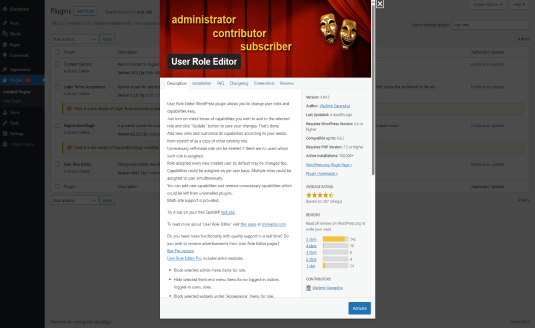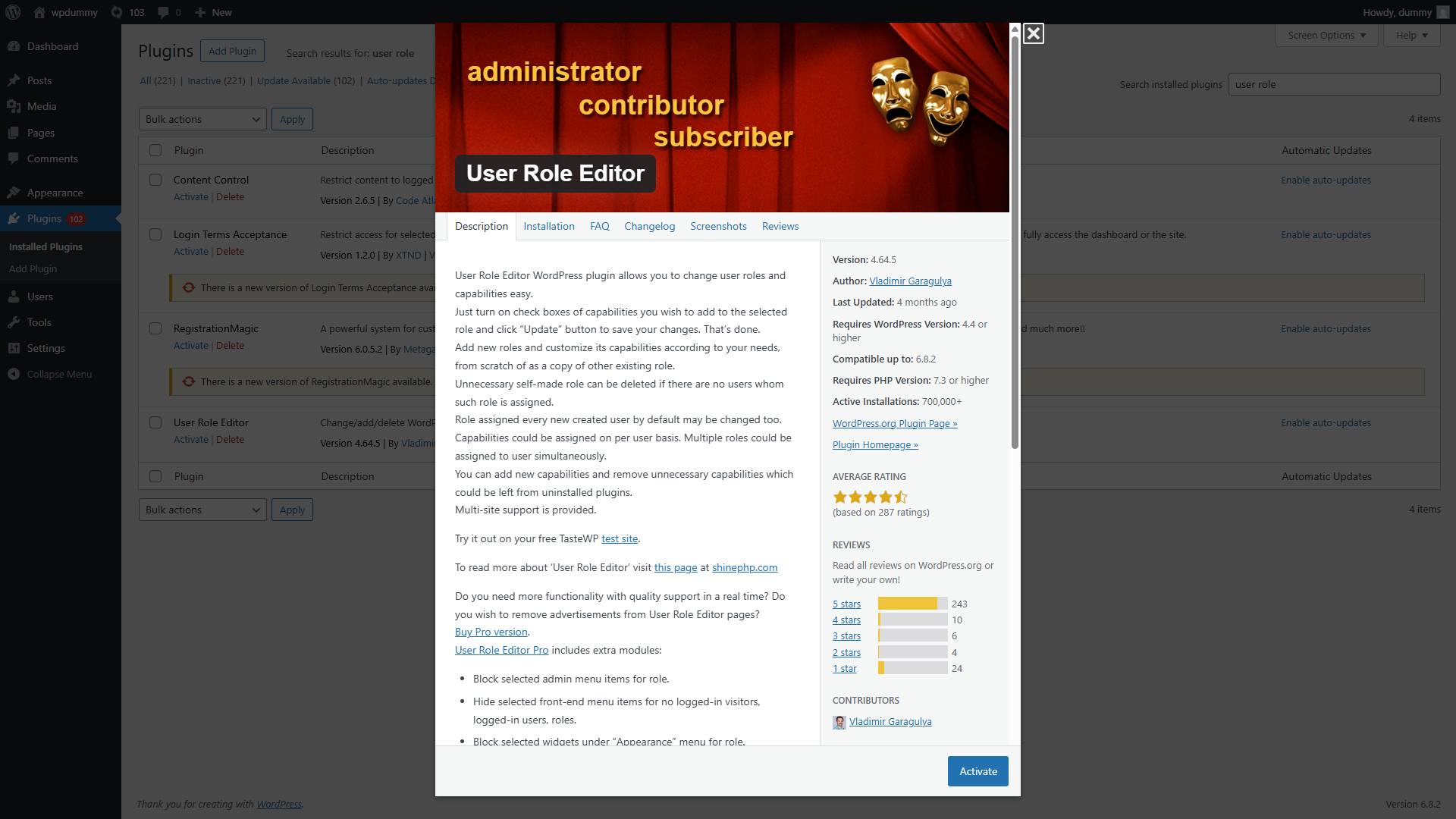User Role Editor WordPress Plugin: A Comprehensive Overview
WordPress is a powerful and flexible content management system (CMS) used by millions of websites worldwide. One of its core strengths lies in its user management system, which allows administrators to assign different roles to users, each with a specific set of capabilities. However, the default WordPress roles and capabilities can be somewhat limited when it comes to advanced permission customization. This is where the User Role Editor plugin comes in.
The User Role Editor plugin extends WordPress’s default user role and capability management system, allowing site administrators to create, edit, and manage roles and permissions with fine-grained control. Whether you’re running a blog, a multi-author news site, a membership site, or an eCommerce platform, this plugin gives you the tools to manage user access precisely as needed.

What is User Role Editor?
User Role Editor is a popular and powerful WordPress plugin developed by Vladimir Garagulya. It allows administrators to manage user roles and capabilities beyond the limitations of the default WordPress roles like Administrator, Editor, Author, Contributor, and Subscriber.
With this plugin, you can:
- Create new user roles
- Edit existing roles
- Change the capabilities assigned to any role
- Assign multiple roles to a single user
- Restrict access to admin menu items, widgets, and shortcodes (in the Pro version)
User Role Editor is available in both free and Pro versions, with the free version available in the WordPress plugin repository and the Pro version offering advanced features for developers, agencies, and large websites.
Key Features of User Role Editor
1. Edit User Roles and Capabilities
The plugin provides a user-friendly interface where you can view and modify the capabilities associated with any WordPress role. You can toggle capabilities such as edit_posts, delete_pages, manage_options, and hundreds of others, depending on your plugins and theme features.
2. Create and Delete Custom Roles
Need a “Project Manager” or “Customer Support” role with specific permissions? With User Role Editor, you can easily create new roles, assign them the capabilities you want, and delete roles you no longer need.
3. Assign Multiple Roles to a User
Out of the box, WordPress allows one role per user. This plugin overrides that limitation and lets you assign multiple roles to a single user, giving them access to combined capabilities from all roles.
4. Per-User Capability Customization
Not only can you manage roles, but you can also assign specific capabilities directly to individual users, allowing for even more tailored permission control.
5. Admin Menu Access Management (Pro Feature)
The Pro version lets you manage access to the WordPress admin menu. You can hide specific menu items from users based on their role, creating a cleaner, less confusing dashboard experience.
6. Widget and Meta Box Access Control (Pro Feature)
Control visibility of widgets and meta boxes in the admin area, helping to reduce clutter and prevent users from changing settings they shouldn’t.
7. Shortcode Access Control (Pro Feature)
Restrict or allow shortcode output based on user roles, which is especially useful for membership sites or content gating.
8. Multisite Support
The plugin works seamlessly with WordPress Multisite, allowing super admins to manage roles and capabilities across the entire network.
9. Integration with Other Plugins
User Role Editor detects and integrates with many popular plugins like WooCommerce, Advanced Custom Fields, WPForms, LearnDash, and more, allowing you to manage plugin-specific capabilities.
Use Cases for User Role Editor
1. Membership Sites
For websites offering tiered access to content (e.g., free vs. premium users), User Role Editor allows the creation of custom roles that control who sees what. You can restrict access to pages, posts, or features based on user roles.
2. E-commerce Sites
WooCommerce adds its own roles and capabilities (like ‘Shop Manager’). With User Role Editor, you can fine-tune these roles to restrict access to financial reports, product editing, or order management.
3. Multi-author Blogs
You may want some authors to have additional privileges, like uploading media or editing others’ posts. Instead of assigning the broad ‘Editor’ role, you can assign only the specific capabilities required.
4. Client Dashboards
If you’re building a WordPress dashboard for a client, you can use this plugin to limit their access only to relevant sections of the backend, such as pages or media, and hide everything else.
5. Agencies and Developers
Web developers and agencies can use this plugin to build role-based admin panels for their clients, ensuring that users only access what they need.
Free vs. Pro Version
| Feature | Free Version | Pro Version |
|---|---|---|
| Create/Edit/Delete Roles | ✅ | ✅ |
| Assign multiple roles to a user | ✅ | ✅ |
| Per-role capability editing | ✅ | ✅ |
| Admin menu access control | ❌ | ✅ |
| Widgets/meta boxes access control | ❌ | ✅ |
| Shortcode content restriction | ❌ | ✅ |
| Front-end menu access restriction | ❌ | ✅ |
| Export/Import Roles | ❌ | ✅ |
| Multisite roles management (extended) | ❌ | ✅ |
| Priority support | ❌ | ✅ |
The Pro version is especially valuable for complex websites where admin interface customization and detailed access control are necessary.
User Interface and Experience
One of the standout features of User Role Editor is its intuitive user interface. Even for users who are not technically inclined, the plugin provides a checkbox-based UI where capabilities can be toggled on or off per role.
Each capability is labeled clearly, and there’s also a helpful filter/search box to find specific capabilities quickly. The interface also highlights capabilities added by third-party plugins, making it easier to manage everything in one place.
Security Considerations
Role and capability management is a sensitive area of WordPress administration. Granting too many capabilities to a user can pose a security risk. Fortunately, User Role Editor includes built-in checks to prevent accidental assignment of powerful capabilities like manage_options or edit_plugins.
Additionally, the plugin warns administrators before changes are saved, and it encourages backups before modifying roles or capabilities.
Performance and Compatibility
User Role Editor is lightweight and well-optimized. It doesn’t slow down the site, even when managing hundreds of users or roles. It’s also regularly updated and tested with the latest WordPress versions.
Its compatibility with other plugins is strong. Developers of the plugin maintain active support and documentation to address compatibility issues with major plugins like:
- WooCommerce
- BuddyPress
- bbPress
- LearnDash
- Easy Digital Downloads
Final Thoughts
The User Role Editor plugin is an essential tool for any WordPress website that needs customized user roles or advanced access control. Whether you’re running a small blog or a large enterprise site, the flexibility and power this plugin offers can help you build a more secure and user-friendly website.
With a free version that covers the basics and a Pro version packed with premium features, it’s no surprise that User Role Editor is one of the most trusted role management plugins in the WordPress ecosystem.





